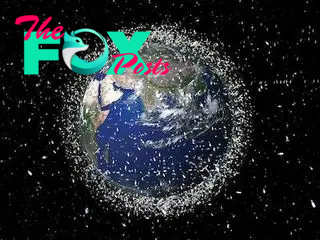Science
Space junk: How broken satellites are creating a garbage crisis in the sky
On June 27, 2024, nine astronauts aboard the International Space Station (ISS) were forced to take shelter in a docked crew capsule after a nearby Russian satellite shattered into more than 100 pieces, showering the sky with potentially hazardous debris.
Though the astronauts returned to the ISS roughly an hour later and resumed operations as normal, the scare brought into sharp focus the growing crisis of space junk in Earth's crowded atmosphere.
Space debris — known colloquially as space junk — is the name that scientists give to the tens of thousands of pieces of broken satellites and spacecraft that clog Earth's orbit. Space junk can be as small as a paint fleck or as large as an abandoned rocket launch vehicle; no matter the size, orbital debris poses a significant threat to the astronauts and spacecraft that work in Earth's orbit, according to NASA.
The amount of space junk in orbit increases hand-in-hand with the growth of the space industry on Earth. On March 10, a group of international researchers writing in the journal Science raised the alarm on the growing problem of space junk, calling for a legally-binding treaty to "help protect Earth's orbit" before it becomes irreparably polluted with debris. Despite this, private companies continue to pump a record number of new satellites into orbit each year — and Earth is starting to see the consequences in ways that are impossible to ignore.
Here's everything you need to know about space junk, and why scientists are concerned.
What is space junk?
Space junk refers to any human-made debris left in orbit around Earth.
This includes fully intact satellites that have run out of power and been left in orbit after the end of their missions, as well as broken chunks of machinery created when larger objects collide. Even tiny chips of paint that have been ripped off of rockets count as space junk.

How much space junk is there right now?
Scientists currently track more than 29,000 pieces of space junk that are larger than a softball, according to the European Space Agency (ESA). This includes about 3,000 defunct satellites that have been left to decay in orbit, according to the Natural History Museum of London.
-

 Science4d ago
Science4d agoInside Capitol Hill’s Latest UFO Hearings
-

 Science4d ago
Science4d agoYou Won’t Want to Miss the Leonid Meteor Shower. Here’s How and When You Can See It
-

 Science5d ago
Science5d agoHere’s What Trump’s Win Means for NASA
-

 Science1w ago
Science1w agoWhy Risky Wildfire Zones Have Been Increasing Around the World
-

 Science1w ago
Science1w agoIt’s Time to Redefine What a Megafire Is in the Climate Change Era
-

 Science1w ago
Science1w ago4 Astronauts Return to Earth After Being Delayed by Boeing’s Capsule Trouble and Hurricane Milton
-

 Science1w ago
Science1w agoThe Elegance and Awkwardness of NASA’s New Moon Suit, Designed by Axiom and Prada
-

 Science2w ago
Science2w agoSpaceX Launches Its Mega Starship Rocket. This Time, Mechanical Arms Catch It at Landing


























